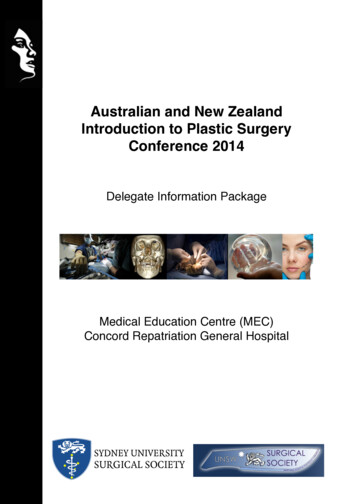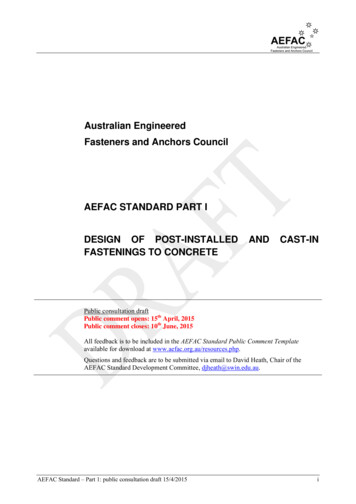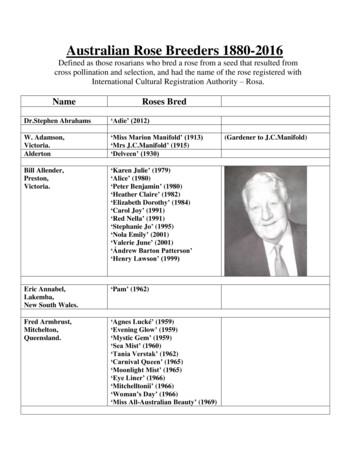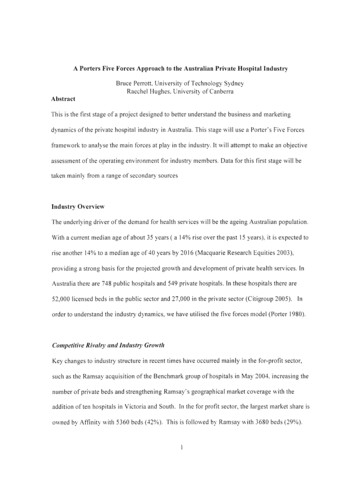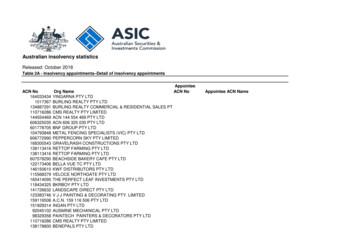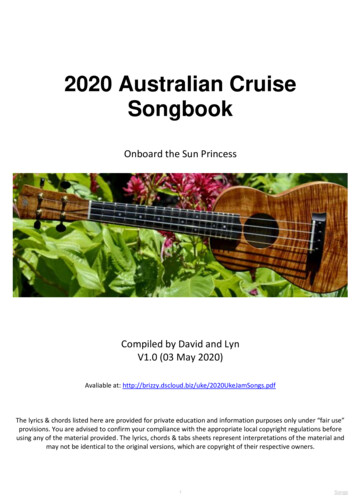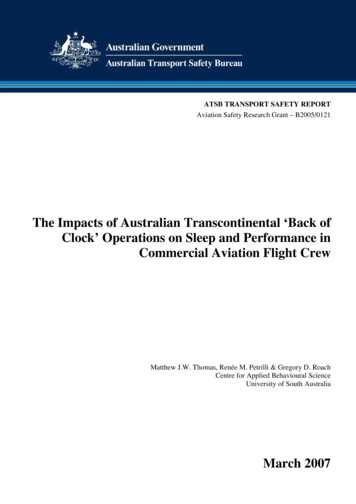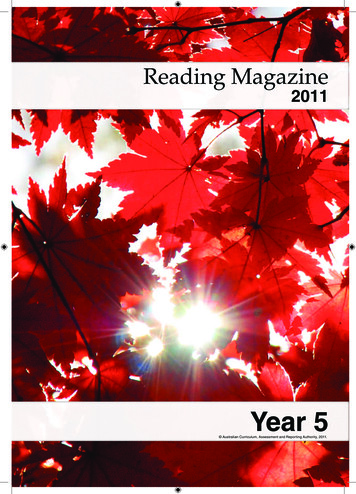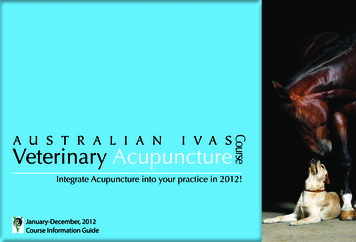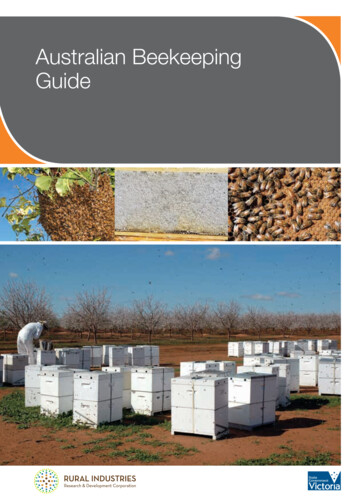
Transcription
Australian BeekeepingGuide
2014 Rural Industries Research and Development Corporation.All rights reserved.ISBN 978-1-74254-715-2ISSN 1440-6845Australian Beekeeping GuidePublication No. 14/098Project No. PRJ-007664The information contained in this publication is intended for general use toassist public knowledge and discussion and to help improve the developmentof sustainable regions. You must not rely on any information contained inthis publication without taking specialist advice relevant to your particularcircumstances.While reasonable care has been taken in preparing this publication to ensurethat information is true and correct, the Commonwealth of Australia gives noassurance as to the accuracy of any information in this publication.The Commonwealth of Australia, the Rural Industries Research and DevelopmentCorporation (RIRDC), the authors or contributors expressly disclaim, to themaximum extent permitted by law, all responsibility and liability to any person,arising directly or indirectly from any act or omission, or for any consequences ofany such act or omission, made in reliance on the contents of this publication,whether or not caused by any negligence on the part of the Commonwealth ofAustralia, RIRDC, the authors or contributors.The Commonwealth of Australia does not necessarily endorse the views inthis publication.This publication is copyright. Apart from any use as permitted under theCopyright Act 1968, all other rights are reserved. However, wide dissemination isencouraged. Requests and inquiries concerning reproduction and rights shouldbe addressed to RIRDC Communications on phone 02 6271 4100.Project Manager and Lead AuthorRussell GoodmanDepartment of Economic Development, Jobs, Transport and Resources (Victoria).Private Bag 15Ferntree Gully Delivery Centre VIC 3156Phone: 03 9210 9324Fax: 03 9210 3521Email: russell.goodman@ecodev.vic.gov.auThe advice provided in this publication is intended as a source of information only.Always read the label before using any of the products mentioned.RIRDC Contact DetailsRural Industries Research and Development CorporationLevel 2, 15 National CircuitBarton ACT 2600PO Box 4776Kingston ACT 2604Phone: 02 6271 4100Fax: 02 6271 4199Email: rirdc@rirdc.gov.auWeb: http://www.rirdc.gov.auElectronically published by RIRDC in January 2015Print-on-demand by Union Offset Printing, Canberra at www.rirdc.gov.auor phone 1300 634 313
ContentsForewordvPrefacevi1. Introduction to the honey bee1Members of the honey bee colony2Caste differentiation4Life-cycle of bee4Workers5Worker bee anatomy6Pheromones8Seasonal size of colonies82. The hive and its components9The hive9Boxes9Bottom boards10Hive covers11Hive mat11Protecting hive components12Branding hive components12Entrance closures12Frames12Wiring frames14Comb foundation15Embedding wire15Plastic frames and foundation16Queen excluder16Hive fastener173. Handling bees and beekeeping safety18Bee stings18Personal protective equipment18Equipment20The smoker and safe operation20How to handle frames and combs22Examining the hive23Ideal conditions for examining the hive24Safety and beekeeping operations254. How to get bees and increase numbers of colonies26Established bee colonies26Nucleus colonies26Package bees27Catching honey bee swarms27Increasing the number of colonies29Secondhand hive components and empty hives30
5. Apiary sites and flora31Winter site31Summer site32Private land sites32Public land apiary sites32Nectar and pollen flora33Nectar fermentation34Pests that affect flora34Hive stocking rates35Drifting bees and placement of hives35Fire Precautions35Identification of apiaries366. Spring management37Stores and feeding bees37Queens39Drone layer queen40Laying workers40Robber bees40Comb replacement41Adding a super to a single box hive41Swarming41Signs of swarming42Causes of swarming42Reducing the impulse to swarm43Division of colonies or artificial swarming44Uniting colonies and splits457. Summer operations47Preparing hives for transport47Transport of hives47Moving bees with open entrances48Loading bees49Moving bees short distances50Water for bees50Bees hanging out52Preparing bees for extreme heat53Adding a super for honey production54Harvesting honey54Removal of bees from honey combs55Comb Honey568. Extracting honey57Uncapping the comb57Honey extractors59Processing the honey crop61Containers for honey61Legal obligations when selling honey62Separating cappings and honey62Further notes for sideline beekeepers63ii Australian Beekeeping Guide
9. Winter management66Locality66Stores66Pollen67Winter cluster and space adjustment67Hive mats, entrances and moisture68Other winter tasks6910. Honey70How bees make honey70Composition of honey71Viscosity of honey71Granulation of honey71Creamed honey71Effect of heat on honey71Filtration71Packaging72Honey standard7211. Beeswax73Properties of beeswax73Sources of beeswax73Wax moth and small hive beetle74Refining wax other than brood combs74Solar beeswax melter75Uses of beeswax7512. Requeening colonies and rearing queen bees76Requeening colonies76Finding a queen77Introducing queens in mailing cages78Introducing a queen by uniting colonies79Queen rearing79Raising queens8013. Brood diseases of bees82American foulbrood (AFB)82European foulbrood disease (EFB)88Sacbrood90Chalkbrood91Stonebrood9214. Diseases of adult bees94Nosema disease94Other adult bee diseases96Diagnosis of adult bee disease9715. Pests and enemies of bees98Wax moth98Damage caused by wax moths99Control of wax moth100Small hive beetle100Ants103Australian Beekeeping Guide iii
Other insects and hive visitors104Birds104Mice105European Wasp10516. Parasites of honey bees107Varroa mite107Braula fly110Honey bee tracheal mite110Tropilaelaps mite111Mellitiphis mite111Comparative diagnosis11217. Quick problem solving table11318. Honey bee pollination118Colony stocking rates119Preparation of colonies for pollination120Pollination contracts12119. Legal124Registration as a beekeeper124Branding hives124Disposal of hives124Moveable frame hives124Notification of bee diseases and pests125Exposure of bees to infected hives and equipment125Access of bees to honey125Interstate movement of bees and used equipment125Chemical use and records125Codes of practice126Packing and selling honey126Honey levy126Water for bees126Smokers and fire126Horticultural areas and local laws12620. Additional information127Beekeeper associations and clubs127Australian Honey Bee Industry Council (AHBIC)127State and Territory Departments of Primary Industries (or agriculture)127Beekeeping journals127Books128Online 132iv Australian Beekeeping Guide
ForewordAustralia’s honey bee and pollination industries make a fundamental contribution to the Australian economy and way of life.Healthy honey bee colonies are necessary for the pollination and economic viability of honey bee dependant horticulturaland seed crops. In addition to commercial and sideline beekeeping enterprises, thousands of hobby beekeepers throughoutAustralia gain considerable recreational pleasure by keeping honey bee colonies.The Rural Industries Research and Development Corporation invests in research and development that is adopted andassists rural industries to be productive, profitable and sustainable. The Corporation seeks to increase knowledge thatfosters sustainable, productive new and established rural industries and furthers understanding of national rural issuesthrough research and development in government-industry partnership.The Rural Industries Research and Development Corporation’s Honey Bee and Pollination R&D Program aims to supportresearch, development and extension that will secure a productive, sustainable and more profitable Australian beekeepingindustry and secure the pollination of Australian horticultural and agricultural crops.The Australian honey bee and pollination industries face a number of significant and economic challenges, including severalbiosecurity threats. These include exotic honey bee parasitic mites that occur in neighbouring countries. Their establishmentin Australia could put at risk the supply of bee colonies for pollination of crops.This book brings together available basic information about the craft of keeping bees and honey bee biosecurity. It willprovide a strong platform for beginner beekeepers to grow their hobby and provide a useful foundation for beekeeperscontemplating beekeeping as a sideline or full-time commercial enterprise.RIRDC funding for the production of this book was provided from industry revenue which is matched by funds providedby the Australian Government. Funds were also provided by the Victorian Department of Economic Development, Jobs,Transport and Resources.This book is an addition to RIRDC’s diverse range of over 2000 research publications and forms part of our Honeybee R&Dprogram, which aims to improve the productivity and profitability of the Australian beekeeping industry.Most of RIRDC’s publications are available for viewing, free downloading or purchasing online at www.rirdc.gov.au.Purchases can also be made by phoning 1300 634 313.Craig BurnsManaging DirectorRural Industries Research and Development CorporationAustralian Beekeeping Guide v
PrefaceThe first successful introduction of European honey bees (Apis mellifera) into Australia occurred in Sydney in 1822.From that small beginning, there are now over 10,790 registered beekeepers and approximately 563,700 hives keptthroughout Australia.Honey bees are kept for the production of honey and beeswax, but most importantly for pollination of honey beedependant horticultural and seed crops. The importance of honey bees for pollination, and this unique and specialisedhoney bee industry, is well recognised by the general public, the Australian Government, and all state and territorygovernments.Keeping honey bees can be a very fascinating and rewarding hobby, as well as a profitable sideline or full time occupation.Beekeeping is essentially a craft that is learned over a number of years. Challenges will occur and mistakes will be made,but accompanying these will be a growing success and reward. It is really a matter of practice, and building experienceand confidence.If you have decided to become a beekeeper, you can easily build your knowledge of bees and beekeeping. You can joina beekeepers’ club, attend beekeeping field days and short courses, and get guidance from books written for Australianconditions. Fact sheets and information may be downloaded from web sites of your state department of primary industries,Rural Industries Research and Development Corporation and Plant Health Australia BeeAware site.This book provides basic information to assist beginner and sideline beekeepers. It draws on the knowledge and experienceof apiculture scientists, various state and territory apiary inspectors and apiary officers, and most importantly, the manybeekeepers who enjoy keeping bees.The book follows in the tradition of its predecessors. Beekeeping in Victoria was first published in circa 1925 and wasfollowed by five revised editions. In 1991, an extensive revision was published under the title Beekeeping.The Australian Beekeeping Guide is an extensive revision of Beekeeping (1991). It builds on the work of our fellow authors ofthat time, Laurie Braybrook, Peter Hunt and John McMonigle. It provides additional information, particularly in the field of beediseases and pests. It contains information about beekeeping in temperate Australia.We wish you every success in beekeeping.Russell Goodman and Peter KaczynskiRussell Goodman is a senior officer – apiculture with the Victorian Department of Economic Development, Jobs, Transportand Resources (DEDJTR)Peter Kaczynski is a former senior apiary inspector with the former Victorian Department of Primary Industries.He is now retired.vi Australian Beekeeping GuidePreface
1. Introduction to the honey beeThe European or Western honey bee (Apis mellifera) is asocial insect that lives in colonies of up to 60,000 adultbees. With many generations of bees being raised, honeybee colonies can live for many years.Honey bee colonies nest in cavities, such as tree hollows,that provide protection from the weather. In today’s world,they also nest in man-made structures such as walls ofhouses, chimneys and compost bins. On rare occasionsthey build their combs in the open, fully exposed to theweather and predators.The honey bee nest has vertical wax combs that consist ofhexagonal cells built on both sides of a midrib. The cells arean engineering masterpiece. Each cell wall forms the wall ofan adjacent cell and so there is no wasted space anywherein the comb. The cells are just the right shape and size toaccommodate the roundish larvae and the pupae that arereared in them.Combs built in the space of a machine.Daniel Martin, DEDJTRAdult worker bees construct comb using beeswax secretedfrom eight wax glands on the underside of their abdomens.The wax initially secreted as a liquid, forms small, irregularlyshaped, wax flakes when in contact with the air. The beesremove these tiny flakes with their feet and knead them intosmall pieces of wax of the desired shape with the help oftheir strong jaws. Little by little, wax is added by the beesto build the cells and entire combs. Although not beingdone continuously, comb construction can be done at greatspeed, if necessary, during times of good nectar flows andexpansion of the brood nest.Bees build worker comb and drone comb. Worker cellsare a little smaller than drone cells. The comparative sizesare best presented as: five worker cells per linear 25.4millimetres of comb and four drone cells per linear 25.4millimetres of comb. The cells have a slight incline withthe opening a little higher than the rear of the cell which issufficient to prevent the partly processed nectar or honeytrickling out.Worker cells are used primarily to raise worker bees and tostore honey and pollen. The cells of drone comb are usedfor raising drone bees, and also for storage of honey andpollen. In nature, bees prefer to store honey in drone comb,but in modern day beekeeping because of the foundationwax sheet used by beekeepers, bees are compelled toconstruct mostly worker comb. This is because highnumbers of drones are considered unnecessary bybeekeepers as they don’t forage for nectar or pollen. Theyare almost a liability in the hive as they always need to befed. Only a few get to mate with a young queen. However,most healthy colonies have a number of drones andperhaps these are good for the ‘morale’ of the colony.1. Introduction to the honey beeCapped brood cells: bullet-shaped drone cells upper half; smallerconvex worker cells lower half.Capped drone cells near wooden top bar of frame; capped and openworker cells remainder of comb. Some open worker cells contain whiteworker larvae.Australian Beekeeping Guide 1
With its own distinctive shape, the queen cell is onlyconstructed when it is necessary for the colony to raisequeen bees. This peanut shaped cell is built on the surfaceor edge of the comb. It is generally gnawed and removedby the bees soon after the new queen has emerged fromthe cell.The question is often asked by those unfamiliar with bees,“why do bees gather nectar and pollen?” The answer issimple. Pollen is the bees’ protein food, providing themwith vitamins, minerals and lipids (fats and their derivatives).Nectar, and honey which is processed from nectar by thebees, provide is their carbohydrate food.A beekeeper should aim to provide bees with the bestopportunities to prosper and store honey. Honey that issurplus to the bees’ requirements can be then harvested bythe beekeeper. However, the greatest benefit of honey beesto humans is the pollination of horticultural and seed crops.Members of the honey bee colonyThe queen and workers are females and the dronesare males. New beekeepers must make it a priority toquickly learn and identify the differences of the castes. It isimportant to acknowledge that all members of a bee colonyrely on each other and cannot survive individually.The QueenThere is normally only one queen in a colony. She is basicallyan egg laying machine and can lay more than 1,500 eggsper day during the peak brood rearing season of springand summer. She is also the largest member of the colonyhaving a long body and tapered abdomen well designedfor backing in to the hexagonal brood cells to lay her eggs.Her abdomen will decrease in size, a little, when the flush ofegg-laying is over for the season, and when she ceases tolay over winter. Her tongue is shorter than that of the workerbee and her sting is not barbed.Queen bee.AsIs Sha’NonComb: yellow-grey capped cells contain honey; brown capped cellscontain worker pupae; open cells with yellow deposits contain pollen.Since the queen mates outside the hive during flight with anumber of drones, her female progeny will consist of severalsub-families who have different father drones but the samemother queen.In nature, queens may live up to five or more years.However, at any time, the colony may rear a new queen toreplace one that is declining in egg-laying capability. Thisdeclining queen will lay in usually four to six queen cellsconstructed by the worker bees. Approximately 16 dayslater, the first fully developed queen that emerges fromher cell will immediately attack all the other queen cells byopening the side walls of cells and stinging the occupants.Nature determines that if another virgin queen has alreadyemerged, then they will fight until one is killed.A capped (sealed) queen cell; worker larvae in open cells.2 Australian Beekeeping GuideSeveral days after emergence, the queen will takeorientation flights to familiarise herself with local landmarks.She will then mate with 14 to 24 drones during matingflights taken over the next few days. Semen is stored in thequeen’s spermatheca where it remains viable. When matingoccurs in poor weather, or very early or late in the seasonwhen the drone population is low, the queen may not havean adequate store of semen and she will be superseded in avery short time.1. Introduction to the honey bee
DronesDrones are rectangular in shape, broader and larger thanworkers and not as long as the queen. The wings are largeand almost cover the stumpy abdomen.There are about 400 drones, and often more, in a colonyduring the main brood rearing season. They are generallyreared from spring to mid-autumn. Although drones don’tforage, their presence in the hive is considered to be goodfor the well-being of the colony. They are not designedby nature to forage and they make no contribution to thecolony’s food supply. Newly emerged drones are fed byworkers for the first few days of their life and older dronesfeed themselves directly from honey stored in the combs.Queen bee on brood comb with attendant worker bees.Most queens in managed hives are generally replacedafter two years by the beekeeper because peak egg-layingdiminishes after that age. Some beekeepers requeen theircolonies annually.WorkersThe worker bee is the most familiar caste to us as she isthe bee we see foraging on flowers in our gardens. She hasa tapered abdomen and is approximately half the weightof the queen or drone, but she is specifically adapted toher tasks in life. The number of workers in a feral honeybee colony may be around 10,000 individuals, but as highas 60,000, or more, in a productive colony managed bya beekeeper. Workers have a number of roles such asfeeding honey bee larvae, building comb, processing nectar,storing pollen, cleaning cells and the hive, removing deadbees, collecting water, foraging for nectar and pollen, anddefending the colony. The worker’s flight is fast, and usuallydirect to and from the hive. She is capable of carrying heavyloads of pollen or nectar. The tongue of the worker is longto enable deep penetration of flowers to reach nectar. Hersting is barbed which she uses exceptionally well in defenceof the colony.The role of the drone is to mate with a virgin queen, but heshows no interest in her inside the hive. Instead, matingoccurs outside the hive and on the wing. Drones arepowerful fliers and have large eyes with approximately 8,000lenses that helps them to detect queens taking matingflights. The compound eyes almost meet on the top of thehead reducing the size of his face. Very few drones matewith a queen and those that do mate, die immediately aftermating. Drones are sexually mature approximately 16 daysafter emergence and live up to ninety days.At times of severe food shortage and during late autumn,drone brood and adult drones are ejected from the hive.Drones are not normally seen during winter althoughsometimes the colony will tolerate some if the colony hasbecome queenless prior to the onset of winter.Drones are larger than workers bees.On this foraging trip, this bee is a nectar gatherer (tongue extended toaccess the flower nectaries) and a pollen gatherer (dark cream pollenpellet forming on hind leg).Maree Belcher1. Introduction to the honey beeAustralian Beekeeping Guide 3
Caste differentiationThe three castes, queen, worker and drone, developthrough each of the life-cycle stages of egg, larvae, pupaeand adult.Female honey bee workers and queens develop fromfertilized eggs that result from the fusion of a sperm cell withan egg cell. There is no genetic difference between the eggthat produces a queen and the egg that produces a worker.Larvae destined to become queens are fed royal jelly inabundant quantities by nurse bees. The jelly is a mixture ofproducts of the hypopharyngeal and mandibular glands ofworker bees. Larvae that are to become workers are fedroyal jelly but on day three onwards they are fed only thesecretion from the hypopharyngeal glands and then later,more pollen and honey. The food given to worker larvaehas less protein, sugars, and vitamins than royal jelly. Theamount of food given to workers is less than the quantity fedto queen larvae.Drones develop from unfertilized eggs and so do not havea father. The queen can control the release of sperm fromher spermatheca into the vagina as the egg passes, andthis enables her to lay both fertilized and unfertilized eggs.The queen is able to measure the size of the brood cellusing her front legs as callipers and determine which cell willreceive a fertilised egg. Drone cells receive unfertilized eggsand smaller worker cells receive fertilized eggs. Drones onlyhave 16 chromosomes and are haploid organisms. Femalebees have 32 chromosomes, 16 from each parent and arereferred to as diploid organisms.Eggs in a worker cells.The cell is then sealed (capped) with a wax cap by workers.The larva then spins a cocoon on the cell walls. Afterspinning its cocoon, the larva lies longitudinally on its backin the cell with its head near the cell opening. This stageis known as the pre-pupal stage. The pupal stage followsin which the larva develops into the fully formed adult. Theready to emerge bee chews the cap around the perimeter ofthe cell and pushes the cap outwards to open the cell andclimbs out. The cap placed on brood cells is porous to allowmovement of air into the cell. The caps on healthy workercells are slightly convex and those on drone cells are domedor bullet-shaped.Life-cycle of beeDevelopment begins with the egg, laid by the queen. Theegg hatches into a small larva, which curls into a small ‘c’shape at the base of the cell. The coiled larva grows quicklyand almost fills the cell.A recently laid egg in a worker cell.4 Australian Beekeeping GuideFigure 1. The major stages in honey bee development. Adaptedfrom The Hive and the Honey Bee, Dadant and Sons, Inc. Usedwith permission.1. Introduction to the honey bee
WorkersAdult workers may live from 15 to 42 days during the busyforaging period of spring, summer and autumn, but canlive right through winter. The variation in lifespan is relatedto pollen consumption and the intensity of brood rearing byworkers. During spring and summer, workers are involved inintensive brood rearing and this may cause workers to havelow body protein levels and reduced longevity. Brood rearingusually declines and may cease altogether during mid to lateautumn and winter. As a result, overwintering workers canhave higher levels of body protein and increased longevity.In general, workers are worn out by ceaseless activity,including foraging.Workers cannot mate, but in queenless colonies, one ormore workers may lay unfertilised eggs in worker cells.These eggs only develop into drones and because workersare not being reared the colony will ultimately die. Theworkers that lay eggs are known as laying workers.Worker larvae in open cells, pupae in capped cells and honey in opencells (right).Guard bees at hive entrance.Drones emerging from their cells.The average period for the stages of development of thehoneybee, from egg to adult, is dependent on environmentaland genetic factors as well as the caste of the larvae(Table 1).There is a general order of tasks for workers to do, but thismay be altered according to the needs of the colony, andto some degree, the age of the individual. During the firstthree weeks of its life, an adult worker may clean cells, feedlarvae, fan air for hive ventilation and cooling, attend to andfeed the queen, cap cells, build comb, pack pollen into cells,receive and process nectar, and carry out guard duties. Inthe latter two to three weeks of their life, during the foodgathering season, workers collect nectar, pollen, water andpropolis. Workers are the only caste that forage.Table 1. Average developmental period of the honey bee worker, queen and drone.Average number of daysEgg hatchLarva inuncapped cellPupa incapped cellTotal number of daysand emergence ofadult from cellWorker35.5Queen34.57.516Drone36.314.5241. Introduction to the honey bee1221Australian Beekeeping Guide 5
Foragers generally only fly as far as they need to collectnectar, pollen and water. A distance of two to threekilometres is common, but they can comfortably fly five tosix kilometres. Sometimes greater distances may be flown,but such long flights require more fuel than the shortertrips and so there comes a point when a long flight is noteconomical.Worker bee anatomyThe head carries the main sensory and feeding organs,including: a pair of antennae used for touch, taste and smell three conspicuous simple eyes and two compound eyes mandibles (mouthparts) that are used for chewing, asa weapon when fighting, and manipulating wax whenbuilding comb proboscis for sucking liquids, honey, nectar and water.Forager resting on almond flower.Bees use water to cool the hive, maintain humidity, and todilute honey when brood food is being produced. A strongcolony may use over a litre of water to cool the hive on ahot day. Water is carried to the hive in the bee’s honey crop,in the same way that nectar is carried. However, water andnectar are never collected together by a bee on the sameforaging trip.Propolis, a gum or resin, collected by worker bees fromplants, is primarily used to seal cracks in the hive. It iscollected on relatively warm days when it is pliable. It iscarried to the hive in the worker’s pollen baskets (See Honeybee anatomy below).Figure 2. External structure of a worker bee. Courtesy The Hiveand the Honey Bee, Dadant and Sons, Inc.Key: AB, abdomen; Ant, antenna; E, Compound eye; H, head; I, propodeum;II–VII, abdominal segments; L1, L2 , L3, legs; Md, mandible; Prb, proboscis;Sp, spiracle; Th, thorax; W2 , W3, wings; 1, prothorax; 2, mesothorax; 3,metathorax.The head also contains the brood-food glands calledhypopharyngeal glands. These secrete royal jelly that is fedto bee larvae and also to the queen. A pair of salivary glandsis located in the head and a second pair in the thorax.Worker bees with proboscis (tongue) fully extended collecting sugarsyrup from a household sponge.6 Australian Beekeeping Guide1. Introduction to the honey bee
The thorax contains the flight muscles and carries the twopairs of wings and three pairs of legs. During flight, theforewings are hooked onto the hind wing by a row of smallhooks located on the leading edge of the hind wings. Thepollen baskets are situated on the hind pair of legs. Thebaskets are slightly concave areas on the outside of thelegs and are specialised to carry pollen that is combed frombody hairs during foraging.Figure 3. Internal view of right half of abdomen of a worker bee.Courtesy The Hive and the Honey Bee, Dadant and Sons, Inc.Key: SntGld, sent gland; Sp, spiracle; WxGld, wax glandForagers with pollen baskets full.The abdomen comprises a number of overlapping externalplates that contain much of the alimentary canal and otherorgans including the sting, wax glands and heart. The platesallow for the expansion and contraction of the abdomenwhich changes in size according to the volume of materialcarried in the honey crop and rectum.The alimentary canal starts at the mouth and includes thesucking pump that enables bees to suck up fluids (nectarand water). The oesophagus is a tube that runs throughthe head and thorax to the honey crop or sac in theabdomen. The crop (also known as honey stomach or falsestomach) is used by the bee to temporarily store and carrynectar, water or food during foraging. The true stomach orventriculus is for digestion and absorption of food. It is linedwith finger-like projections termed ‘villi’ which release cellsinto the stomach where they breakdown to liberate digestiveenzymes. Water is absorbed in the intestine. Food wasteis accumulated in the rectum, which can expand to hold alarge quantity of faeces that accumulate over period of timewhen bees are unable to fly and defecate outside the hive.Figure 4. The alimentary canal and other internal organs of a worker bee. Courtesy The Hive and the Honey Bee, Dadant and Sons, Inc.Key: alnt, anterior intestine; an, anus; Ao aorta; Br brain; dDph, dorsal diaphragm;
The importance of honey bees for pollination, and this unique and specialised honey bee industry, is well recognised by the general public, the Australian Government, and all state and territory governments. Keeping honey bees can be a very fascinating and rewarding hobby,
